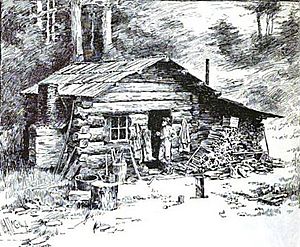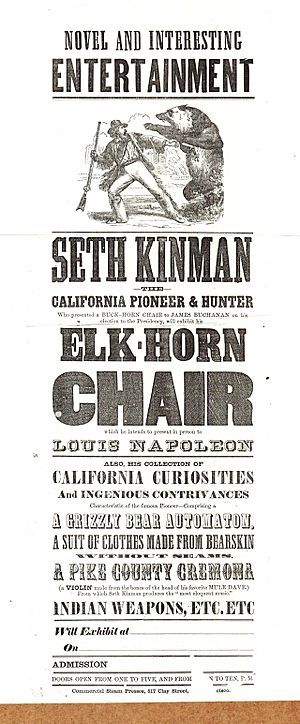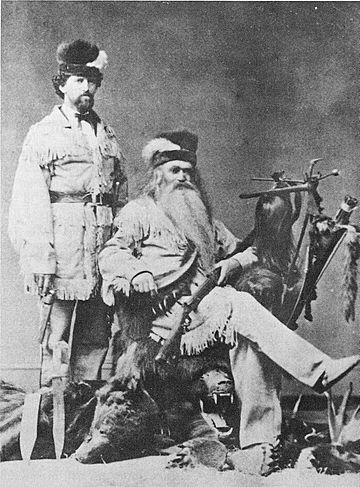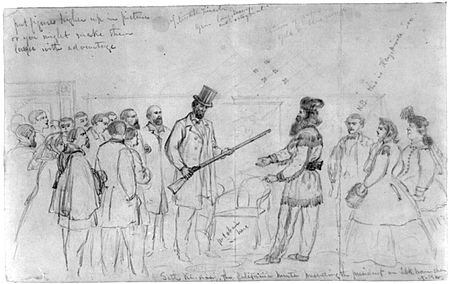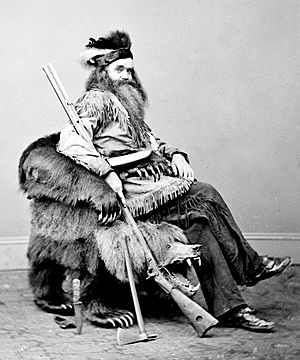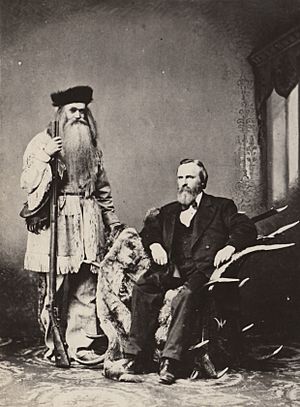Seth Kinman facts for kids
Quick facts for kids
Seth Kinman
|
|
|---|---|
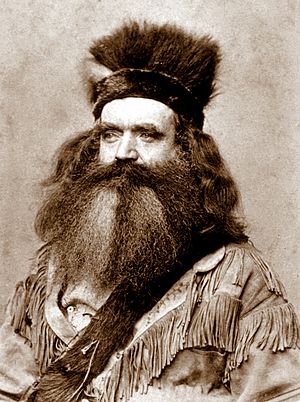
Carte de visite of Seth Kinman in 1864
|
|
| Born | September 29, 1815 Union County, Pennsylvania (40°38′56″N 124°12′32″W / 40.649°N 124.209°W)
|
| Died | February 24, 1888 (aged 72) Table Bluff, California
|
| Cause of death | Accidental gunshot wound |
| Resting place | Table Bluff Cemetery, Loleta, California |
| Occupation |
|
| Known for | Presidential chairs |
| Spouse(s) |
Anna Maria Sharpless
(m. 1840; died 1853) |
| Children | 5 |
| Signature | |
Seth Kinman (September 29, 1815 – February 24, 1888) was an early settler in Humboldt County, California. He was a skilled hunter, a famous chair maker, and a well-known entertainer across the United States. Seth Kinman was over 6 feet tall. He was known for his hunting skills, especially with grizzly bears and elk. He claimed to have hunted more than 800 grizzly bears and over 50 elk in just one month.
Kinman also ran a hotel and a saloon. He was a musician who played the fiddle. He even performed for President Abraham Lincoln on a special fiddle made from the skull of a mule. Seth Kinman enjoyed being in the public eye. He often dressed in buckskin clothes, like a traditional mountain man. He sold small photos of himself and his unique chairs. These chairs were crafted from elk horns and grizzly bear skins. He gave these special chairs to several U.S. Presidents. Presidents who received his chairs include James Buchanan, Abraham Lincoln, Andrew Johnson, Ulysses S. Grant, Rutherford B. Hayes, and Grover Cleveland.
Contents
Seth Kinman: Hunter and Chair Maker
Early Life and Adventures
Seth Kinman was born in 1815 in Uniontown, Pennsylvania. His father, James Kinman, operated a ferry across the West Branch Susquehanna River. James was also a millwright, someone who builds or repairs mills, and an inn-keeper. Seth learned to read and write in Pennsylvania. In 1830, his family moved to Tazewell County, Illinois.
Seth said that his father fought in the Black Hawk War in Illinois in 1832. He also claimed his father and Abraham Lincoln became friends after fighting together. Seth said he met Lincoln when Lincoln was a lawyer traveling around Illinois. During this time, the Kinman family got a rifle they called "Old Cotton Bale." Seth kept this rifle his whole life.
Seth worked for ten years in his father's mill, cutting wood and grinding grain. After his father passed away in 1839, Seth sold the mill and tried farming. In 1840, he married Anna Maria Sharpless. They had five children together. Sadly, Anna Maria and two of their sons died in the winter of 1852–53 while Seth was in California. By 1848, Kinman was running the Eagle Hotel in Pekin, Illinois. The hotel was known for Seth playing his favorite fiddle tune, "Arkansas Traveler."
Life in California
Kinman said he moved to California in 1849 during the famous California Gold Rush. He worked as a gold prospector on the Trinity River. He then went back to Illinois for two years. In 1852, he returned to California and explored the Humboldt Bay area. This area is near what is now Eureka, California. Gold miners had recently found Humboldt Bay again. They were looking for a faster way to get supplies.
On Christmas Day in 1852, Kinman was paid a large amount, $50, to play his fiddle at a Christmas ball. This was a lot of money back then, even though he wasn't a trained musician. In 1853, he started working as a hunter. He provided food for U.S. troops at Fort Humboldt. While there, he met future president Ulysses S. Grant. He also met future General George Crook. People say he brought the first herd of cattle to Humboldt County around this time.
Kinman lived in several places in Humboldt County. In October 1858, he bought 80 acres of land near Table Bluff Lighthouse. This was the first land bought in that area. He later built a hotel and a bar on his property. Kinman became famous as a hunter, especially for hunting grizzly bears. California used to have many grizzlies. Seth's son Carlin claimed they once saw 40 grizzlies at one time. However, by 1868, the last grizzly in Humboldt County had been hunted.
A Brave Rescue
During a strong storm on January 5–6, 1860, Kinman heard distress signals. A ship called the Northerner had hit a hidden rock. Kinman tied himself to the shore and walked into the rough ocean to help rescue passengers. In total, 70 people were saved, but 38 people died. He was seen as a hero for his actions. He received a Bible and free lifetime travel on the Pacific Mail Steamship Company's ships.
Relations with Native Americans
Native Americans in northern California faced many challenges during the mid-1800s. Their population decreased a lot. The Wiyot people, who lived around Humboldt Bay, were especially affected. Their population dropped from about 1,500-2,000 in 1850 to about 200 in 1860. In May 1860, Seth Kinman was chosen to represent his area at a meeting. This meeting was held to discuss ways to protect white settlers from Native Americans. In 1864, he worked as a scout for Captain William Hull's California Volunteers. Kinman said they captured many Native Americans and took them to Fort Humboldt.
An Entertainer's Life
After giving a chair to President Buchanan in 1857, Kinman said he "awoke one fine morning and found myself famous." He used this fame to become an entertainer. In the summer of 1861, he opened an exhibit with a ventriloquist and magician named J. G. Kenyon. They first showed their exhibit in Eureka, then in San Francisco. Kinman displayed his "curiosities," which included an elkhorn chair, mounted grizzly bears, and several fiddles. He also gave talks to the audience.
They toured gold mining camps and the San Francisco Bay area as entertainers. Later, he opened a traveling "museum of curiosities" in Eureka, San Francisco, Sacramento, and Los Angeles. During his trip to the East Coast from 1864 to 1866, Kinman showed his curiosities, including his chairs, mainly in Pennsylvania and Illinois. As late as 1885, Kinman opened a museum in Los Angeles with his sons Carlin and Roderick.
Famous Chairs for Presidents
Kinman first used the many elkhorns found near his farm to build a fence. Around 1856, he made his first elkhorn chair with the help of George Hill. He traded this chair for a telescope. To build an elkhorn chair, he used matching horns for the front legs and arms. Other horns formed the back legs and chair back. He added an elk-hide seat and even used elk feet for the chair's feet.
Inspired by the 1856 election of James Buchanan, who was also from Pennsylvania, Kinman built his first presidential elkhorn chair. He brought it to Washington D.C. He got free passage on a ship to Panama, then to New York, and finally to Washington. On May 26, 1857, Kinman presented the chair to President Buchanan. The President was very happy with the gift. In return, he bought Kinman a rifle and two pistols.
Kinman presented an elkhorn chair to President Abraham Lincoln on November 26, 1864. An artist named Alfred Waud drew a picture of this moment. It is the only known picture of Lincoln receiving a gift. The drawing shows Lincoln looking at Kinman's rifle, which he called "Ol' Cottonblossum." Kinman also gave Lincoln a fiddle made from the skull and a rib of his favorite mule. He played the instrument for Lincoln. Lincoln found it very amusing.
In April, Kinman marched in President Lincoln's funeral procession in Washington. He also escorted Lincoln's body part of the way to its burial in Ohio. On April 26, 1865, the New York Times described Kinman in the funeral procession in New York City. They noted he wore a full buckskin hunting suit with a rifle on his shoulder.
During his time on the East Coast, many photos of Kinman and his chairs were taken by Mathew Brady. Kinman sold these photos, even in the United States Capitol. He also traveled around the country, performing as a frontier storyteller and fiddle player in his buckskins.
Kinman's most impressive presidential chair was given to President Andrew Johnson on September 8, 1865. This chair was made from two grizzly bears that Seth had hunted. It had four legs and claws from a huge grizzly bear. The back and sides were decorated with large claws. The seat was soft and comfortable. A special part of the chair was that if you pulled a cord, the head of a grizzly bear would pop out from under the seat. It would appear to snap and gnash its teeth, looking very real. Johnson kept this chair in his White House library.
On September 18, 1876, Kinman gave an elkhorn chair to Governor Rutherford Hayes of Ohio. Hayes soon became the President of the United States. This chair is now on display at the Rutherford B. Hayes Presidential Center in Fremont, Ohio. He later gave a chair made of bearskin and other bear parts to Hayes's vice-president, William A. Wheeler.
His Legacy and Guns
In 1876, Kinman told his life story to someone who wrote it down. These memoirs were finally published in 2010. He also kept a large scrapbook of newspaper articles about himself. In his later years, Kinman lived in Table Bluff, California with his family. He owned a hotel and a bar there. In 1886, Kinman was getting ready to send chairs to President Grover Cleveland and General Winfield Scott Hancock. Seth Kinman passed away in 1888 after accidentally shooting himself in the leg. He was buried in Table Bluff Cemetery in Loleta, California, wearing his buckskin clothes.
In 1893, Mrs. R.F. Herrick bought Kinman's traveling museum collection. It had 186 items, including at least two of his famous chairs. She displayed them in San Francisco and then at the 1893 World's Columbian Exposition in Chicago. The Ferndale Museum displays some of Kinman's items, including one of his buckskin suits.
Unique Fiddles and Rifles
At least two of Kinman's guns are believed to still exist. His long rifle called "Old Cotton Blossum" was put up for sale in 2018. It was estimated to sell for $20,000 to $40,000. One of the two pistols given to Kinman by President Buchanan was shown on Antiques Roadshow. It was valued for insurance at about $50,000. It is a 36 caliber Colt model 1851 pistol. Kinman changed the pistol by trimming the hammer and adding a front sight made of horn or bone.
Images for kids
-
Mule skull fiddle and chair displayed at the World's Columbian Exposition.


